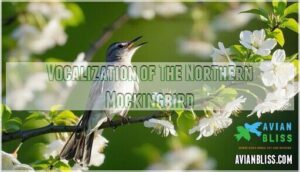This site is supported by our readers. We may earn a commission, at no cost to you, if you purchase through links.

Think of the Resplendent Quetzal, flashing emerald feathers and a tail that practically waves hello.
Or picture the Scissor-tailed Flycatcher, slicing the air with dramatic flair—those tails aren’t just for show.
Long tails help balance in flight, attract mates, and even camouflage against clever predators.
Each type, from racquet-shaped to streaming ribbons, tells its own story.
It’s almost like the bird world’s fashion show: every feather has a purpose, every display a secret.
Curious which species truly turn heads? Wait until you meet the next batch.
Table Of Contents
- Key Takeaways
- Birds With Exceptionally Long Tails
- Reasons for Long Tails in Birds
- Types of Long Tails in Birds
- Birds With Racquet-Shaped Tails
- Tropicbird Tail Streamers
- The White-tailed Tropicbird
- Vocalization of The Northern Mockingbird
- Taxonomy and Distribution of The Northern Mockingbird
- Habitat and Range Expansion of The Northern Mockingbird
- Similar Species to The Northern Mockingbird
- Frequently Asked Questions (FAQs)
- What birds have long tails?
- What is the longest tailed bird?
- Which birds have long tail extensions?
- What birds have large tail feathers?
- Do hummingbirds have a long tail?
- Which California bird has a floppy tail?
- What kind of bird has two long thin tails?
- What is a small white bird with a long tail?
- What birds have really long tails?
- What is a GREY bird with a long tail?
- Conclusion
Key Takeaways
- You’ll find that birds with long tails, like the Resplendent Quetzal and Indian Peafowl, use their tails for balance and communication, making them a crucial part of their survival and reproduction.
- Some birds, such as the Reeves’s Pheasant, have extremely long tails – up to 94-95 inches – which is a remarkable sight, and you’ll notice that these long tails often serve as a visual display to attract mates.
- You’ll discover that different species have unique tail shapes and lengths, such as racquet-shaped tails, which aid in flight, balance, and visual displays, and each type has its own specific function and purpose.
- As you explore the world of birds with long tails, you’ll learn that these species have adapted to their environments in remarkable ways, using their tails to signal fitness and attract mates, making them a true marvel of evolution and design.
Birds With Exceptionally Long Tails
You’re about to explore some amazing birds with exceptionally long tails, and it’s worth noting that these tails often serve important purposes.
As you read on, you’ll discover how birds like the Resplendent Quetzal and the Fork-tailed Flycatcher use their long tails for balance, courtship, and other essential functions.
Resplendent Quetzal (male)
You’ll admire the Resplendent Quetzal’s vibrant Quetzal Plumage and long tail, essential for mating rituals and display.
Showcasing its unique beauty in its native habitat, highlighting the importance of conservation due to habitat loss.
Fork-tailed Flycatcher (male)
You’ll notice the Fork-tailed Flycatcher’s impressively long tail, aiding in:
- Courtship behavior
- Foraging strategies
- Balance during flight
- Signaling breeding fitness
- Exploring habitat preference, showcasing its unique Tail Morphology and Aerial Acrobatics for mating success.
Scissor-tailed Flycatcher
You’ll observe the Scissor-tailed Flycatcher’s long, forked tail, up to twice its body length, as it performs aerial acrobatics for mating displays.
Showcasing its unique habitat preferences and diet composition as a long-tailed bird species.
Black-throated Magpie Jay (male)
You’ll discover the Black-throated Magpie Jay’s long, elegant tail is used in elaborate mating displays, social foraging, and as a visual deterrent, showcasing its unique plumage coloration.
It is a trait shared among long-tailed birds, like the White-throated Magpie-Jay, with cooperative breeding habits.
Turquoise-browed Motmot
You’ll explore the Turquoise-browed Motmot, with its stunning, iridescent tail feathers, unique vocal mimicry, and Motmot Habitat.
Learning about its Motmot Diet, Behavior, and Conservation, while understanding bird tail length and species identification through its distinctive Motmot Plumage.
Reasons for Long Tails in Birds
You’re about to explore the fascinating reasons behind birds’ long tails, and it’s likely that you’ll discover it’s not just about looks.
As you learn more, you’ll find that long tails serve various purposes, including attracting mates, maintaining balance, and signaling fitness to females.
Signaling Good Breeding Fitness to Females
You’ll find that longtailed birds use tail ornamentation as powerful fitness indicators through sexual selection.
Long-tailed birds flaunt their feathers as bold signals of strength, attracting mates with every striking display.
When males display these elaborate features, they’re basically advertising their genetic quality to potential mates. The handicap principle explains this phenomenon perfectly – maintaining such impressive plumage requires significant energy, proving superior health.
Female choice drives this evolutionary trait, particularly evident in the Longtailed Widowbird during courtship displays. One example is the Ribbon-tailed Astrapia’s unique feathers.
- Vibrant tail feathers catching sunlight like nature’s spotlight
- Males strutting with confidence, tails fanned in perfect displays
- Females carefully evaluating each suitor’s ornamental quality
- Genetic superiority demonstrated through costly tail maintenance
Attracting Mates During Courtship
You’ll witness nature’s most spectacular courtship rituals when male birds deploy their long tail feathers as visual displays.
Through sexual selection, these tail ornaments become powerful fitness signals that drive female choice.
Males perform elaborate mating rituals, fanning, shimmering, and dancing their ornate tails to showcase their genetic quality and secure breeding opportunities.
Camouflage and Concealment
Long tails aren’t just for show—they’re nature’s invisibility cloak. Disruptive coloration breaks up body outlines, while seasonal camouflage helps birds adapt to changing environments. Tail patterns create visual confusion for predators.
The plumage of the American bittern blends seamlessly into reeds.
Key evolutionary adaptations include:
- Habitat blending – Bird tail plumage matches surroundings perfectly
- Behavioral concealment – Strategic positioning maximizes bird tail colors effectiveness
- Bird tail adaptations – Countershading reflects light differently based on angles
Balance and Stability in Flight
Think of a bird’s tail as its built-in steering wheel. Tail aerodynamics boost balance during flight and fine-tune steering capabilities, letting birds pivot and dive with skill.
Tail morphology varies by species, but each adapts to evolutionary pressures and energetic costs. Strong tail feathers give better flight maneuverability, supporting the bird’s acrobatics and stability.
- Improved mid-air balance
- Enhanced direction changes
- Essential for precise landings
Aerodynamic Advantages
Building on balance and stability, bird tail aerodynamics give you more than show—they ramp up flight efficiency and boost drag reduction. With long tail feathers controlling every twist and turn, birds enjoy incredible steering capabilities.
That means stability enhancement for tricky maneuvers and foraging adaptations in tight spaces. It’s tail maneuverability at its scientific best! Tail length often signals genetic fitness, playing a vital role in sexual selection.
| Tail Function | Benefit | Fun Fact |
|---|---|---|
| Balance during flight | Stability | Some birds “steer” like pilots |
| Drag reduction | Better efficiency | Extra length—worth the cost! |
| Steering capabilities | Quick turns | Helps nab tasty insects fast |
Types of Long Tails in Birds
You’ll find that birds have developed several impressive tail types, including cord-like streamers, ribbon-shaped feathers, and even racquet-tipped designs.
Each shape isn’t just for show—it serves a scientific purpose, from boosting aerial agility to catching the eye of a potential mate, which can be seen as a way to enhance their aerial agility.
Cord-like Streamers
You’ll often spot birds sporting cord-like streamers on their tails—nature’s answer to style and speed.
These streamers are marvels of bird tail morphology, designed to boost Streamer Aerodynamics and help with balance.
Here’s what makes them stand out:
- Drive Display Evolution
- Signal fitness through Streamer Length
- Enhance Streamer Function in-flight
- Add camouflage to bird species tails
- Showcase unique Material Composition
Double Ribbon-like Tails
You’ll notice birds like the Ribbon-tailed Astrapia have double ribbon-like tails, enhancing their display function and mating success with unique feather structure, an adaptation for survival.
These feathers can even improve flight control, showcasing stunning long tail feathers in various bird species tails, with bird tail morphology playing a vital role in their evolution and survival.
Racquet or Spatula-shaped Tails
You’ll often see racquet or spatula-shaped tails, like those on motmots and the Marvelous Spatuletail.
These bird tail shapes aren’t just for show! The Motmot tail swing and other bird tail displays are fascinating. Racket function includes courtship and stability.
- Display variations
- Tail regeneration
- Greater Racket-Tailed Drongo
- Spatuletail evolution
These unique bird tail functions, showcasing sexual dimorphism, make them a striking feature.
Iridescent or Shimmering Tails
Now, let’s check out iridescent or shimmering tails! You know, the kind that seems to change color as you move? It’s all about iridescence origin and feather structure.
These tails:
- Show vivid, color shifting hues.
- Boost attractiveness.
- Help with camouflage.
The bird tail feather color and bird tail feather pattern serve as visual signaling and offer an evolutionary advantage. Bird tail displays like this are plumage perfection!
Elongated Tail Coverts
You’ll discover elongated tail coverts, enhancing display behaviors in birds like Resplendent Quetzal and Fork-tailed Flycatcher.
These long, narrow feathers play a role in Covert Evolution, showcasing Covert Functionality and Covert Coloration.
With Covert Aerodynamics, they aid in flight, while Covert Display highlights their unique plumage.
Elongated tail coverts are a key aspect of bird tail anatomy, influencing tail feathers and characteristics, making them a fascinating topic in the study of long tail feathers and their importance in bird behavior.
Birds With Racquet-Shaped Tails
You’ll notice that birds with racquet-shaped tails, like motmots and the Indian Peacock, have unique tail feathers.
As you explore these species, you’ll see how their distinctive tails play a role in communication, courtship, and overall survival.
Motmots
These forest jewels sport nature’s most distinctive tail design – a racquet shape that’s truly eye-catching.
You’ll find motmots throughout Central and South American rainforests, where their unique tail anatomy serves multiple purposes.
Their distinctive plumage features vibrant blues and greens, making bird identification easier in dense canopies.
- Motmot Behavior: They swing their tails like pendulums during displays
- Motmot Diet: Primarily insects, small reptiles, and tropical fruits
- Motmot Habitats: Dense tropical forests with abundant perching sites
- Motmot Conservation: Most species remain stable, though deforestation threatens some populations
Booted Racket-tail Hummingbird
You’ll spot the Booted Racket-tail hummingbird’s signature racquet-shaped tail feathers working overtime during courtship displays in Andean cloud forests.
These specialized tail morphology features create mesmerizing flight patterns that showcase the bird’s mating rituals while demonstrating perfect habitat specifics adaptation.
| Characteristic | Details |
|---|---|
| Tail Feathers | Distinctive racquet-shaped tips for courtship |
| Habitat Specifics | Andean cloud forests, high elevation |
| Mating Rituals | Elaborate aerial displays using tail |
| Conservation Status | Vulnerable due to habitat loss |
This hummingbird species uses its unique bird tail characteristics for both bird identification purposes and specialized bird anatomy functions, making these tail feathers essential for successful reproduction and species survival.
Red-billed Tropicbird
Red-billed Tropicbirds showcase nature’s artistry with their tail streamers that flutter like ribbons in ocean breezes.
These seabirds use their elegant tail feathers for courtship displays and flight stability.
You’ll spot their slim white bodies, black eye lines, and distinctive red bills across tropical waters.
Their breeding habits involve cliff-side nesting, while their diet consists primarily of fish and squid caught through spectacular diving displays.
Indian Peacock
The Indian Peacock truly struts its stuff with spectacular tail feathers that’d make any runway model jealous.
You’ll find these iridescent plumes aren’t just for show—they’re essential tools in the bird’s courtship arsenal.
- Peacock Plumage: Features over 200 eye-spotted feathers that shimmer with blues, greens, and golds during mating rituals
- Indian Peafowl Habitat: Thrives in forests, grasslands, and agricultural areas across the Indian subcontinent
- Courtship Displays: Males fan their magnificent tails while strutting and calling to attract females during breeding season
- Peacock Conservation: Protected in many regions, though habitat loss threatens wild populations of these stunning birds with long tails
Tropicbird Tail Streamers
You’ll find tropicbirds sporting elegant white streamers that flow about 4.7 inches behind their sleek bodies, creating a striking silhouette against ocean skies.
These specialized tail feathers serve dual purposes, helping males attract mates through graceful aerial displays while providing extra stability during their impressive plunge-diving hunts for fish.
Male’s Tail Streamers Slightly Longer Than Female’s (4.7 Inches)
You’ll notice sexual dimorphism in tropicbird tail streamers, where males sport slightly longer feathers than females at 4.7 inches.
This length significance creates streamer asymmetry that signals genetic fitness during courtship displays.
The evolutionary pressure for extended tail length gives males a mating advantage, as females prefer partners with superior plumage quality indicating robust health and breeding potential.
Used in Elaborate Courtship Displays
While male tropicbirds sport slightly longer tail streamers, these elegant feathers truly shine during courtship rituals.
Males perform synchronized aerial dances, using their streamers for Visual Signaling and Species Recognition. This Display Evolution demonstrates how Tail Ornamentation influences Mate Choice in birds with long tails.
Key courtship behaviors include:
- Synchronized flight patterns where males showcase streamer flexibility and control
- Aerial acrobatics that highlight plumage quality and physical fitness
- Hovering displays near nesting cliffs that emphasize streamer length and grace
These elaborate performances represent millions of years of bird behavior evolution, where longer streamers consistently attract more mates.
Can Be Plucked by Frigatebird Kleptoparasites
Frigatebirds ruthlessly target tropicbird tail streamers through aggressive aerial harassment. These Magnificent Frigatebird attacks cause significant Kleptoparasitism Impact on seabirds, with some colonies showing 80% of birds experiencing bird tail damage.
Frigatebirds snatch tail streamers mid-air, leaving tropicbirds with little more than shredded feathers and bruised pride.
The Tropicbird Vulnerability to such predators creates lasting effects on breeding success. The length of these feathers can signal genetic fitness and health.
Frigatebird Tactics include:
- Aerial pursuit – Chasing tropicbirds until streamers break free
- Direct plucking – Grabbing tail feathers mid-flight during displays
- Repeated harassment – Multiple attacks weaken Feather Composition over time
Tail Feather Regrowth requires entire breeding seasons, leaving birds defenseless against further bird tail predation defense challenges.
Help Attract Mates and Enhance Flight Stability
You’ll find that tail morphology plays a dual role in tropicbirds’ survival strategy.
These flight dynamics specialists use their streamers for impressive courtship displays, where longer tails signal superior genetic quality to potential mates.
The aerodynamic efficiency comes with evolutionary tradeoffs – while streamers enhance flight maneuverability during complex aerial courtship routines, they also create drag that demands extra energy for sustained flight.
The White-tailed Tropicbird
You’ll recognize the white-tailed tropicbird as a sleek, gray-bodied seabird with striking white wing patches and distinctive white-edged tail streamers that flutter behind it during flight.
This elegant marine bird measures about 10 inches in total length and displays a thin black eye line that creates a distinctive facial marking against its otherwise pale plumage.
Slim Gray Bird With Flashy White Wing Patches
White-tailed Tropicbirds captivate observers with their elegant design.
These sleek seabirds display remarkable plumage featuring:
- Brilliant white wing patches that flash like beacons against ocean blues
- Streamlined gray bodies perfectly built for diving and soaring
- Contrasting black eye lines that give them a masked, mysterious appearance
Their wing patch function aids in species recognition during flight, while plumage variations help distinguish them from other tropical seabirds during bird identification.
White Edges on Long Tail Feathers
You notice the white-tailed tropicbird’s tail feathers have striking white edges, creating contrast with its gray body.
This Feather Edge Pigmentation enhances the White Edge Function, showcasing Edge Pattern Variation and Edge Color Genetics in bird tail feathers, specifically in bird tail patterns and plumage.
Thin Black Eye Line
You observe the White-tailed Tropicbird’s thin black eye line, a striking contrast to its pale plumage, aiding in glare reduction and visual communication.
This aspect is a key part of bird identification, particularly for species variation and predator avoidance among birds with long tails, where the thin black eye line plays a crucial role.
Total Length Around 10 Inches
You’re exploring birds with long tails, and the White-tailed Tropicbird’s 10-inch total length is impressive.
Its striking tail aiding flight maneuverability and camouflage, an ideal example of evolutionary advantages in bird species with long tails and unique plumage, is a notable feature.
The combination of its long tails and unique plumage contributes to its distinctive appearance and abilities.
Vocalization of The Northern Mockingbird
You’ll find the Northern Mockingbird’s vocalization quite impressive. Some key aspects include:
- Mimicry accuracy
- Song complexity
- Vocal learning
- Regional dialects
Their call functions as a means of communication, conveying information about territory and identity.
Learn about mockingbird vocalization products online.
Studies on bird behavior patterns show that mimicry abilities play a significant role in their social interactions, with each bird having its unique bird tail behavior and communication cues.
Taxonomy and Distribution of The Northern Mockingbird
You’re exploring the taxonomy and distribution of the Northern Mockingbird, a species with a scientific name of Mimus Polyglottos.
As you learn about this bird, you’ll find it’s a permanent resident across the entire continental US, with a range that extends to Cuba and Mexico, and a narrow margin along the Canadian border, which is part of its distribution.
Scientific Name: Mimus Polyglottos
You’re exploring the Northern Mockingbird’s scientific name, Mimus Polyglottos.
This species’ tail feathers aid in courtship displays and aerodynamics, like the White-tailed Tropicbird.
For further information, consider the available Mimus Polyglottos guides.
| Tail Feathers | Function |
|---|---|
| Long | Balance |
| Colorful | Attraction |
The provided information aims to educate readers about the Northern Mockingbird.
Northern Only by Comparison to The Tropical Mockingbird
You’re comparing the Northern Mockingbird to its tropical counterpart, noting differences in Mockingbird Evolution, Plumage Comparison, and Mimicry Differences.
With varying tail lengths among bird species, highlighting unique characteristics within bird habitats and distribution, especially among tropical birds.
You can find products related to the mockingbird’s range here, which is an essential aspect of understanding the tropical birds and their distribution.
Permanent Resident Across The Entire Continental U.S
You’ll discover Northern Mockingbirds are permanent residents across the entire continental US, adapting to various habitats with unique tail feathers.
They showcase remarkable adaptation strategies for winter survival, and highlighting regional variations in their conservation status as a common bird species.
Narrow Margin Along The Canadian Border
You’re nearing the Canadian border, where Border Birdlife thrives.
Here are key points:
- Habitat Overlap
- Migration Patterns
- Conservation Efforts
- Climate Impacts
- Bird tail adaptation, with species having long tails, like the Northern Mockingbird, with distinctive tail feathers.
The provided list outlines essential aspects of birdlife in the area, including Habitat Overlap and other critical factors.
Cuba and Mexico South to Oaxaca
You’re exploring the Northern Mockingbird’s range, which extends to Cuba, Mexico, and Oaxaca, showcasing Regional Endemism and Avian Migration.
With Conservation Efforts needed to protect its Habitat, featuring unique bird identification tails, like Quetzals and Turquoise-browed Motmot.
With various types of long tails and tail feathers, the Northern Mockingbird’s range is also home to other birds, but Avian Migration patterns are a key area of study.
Habitat and Range Expansion of The Northern Mockingbird
As you explore the realm of birds, you’ll find the Northern Mockingbird’s habitat and range expansion fascinating.
They inhabit urban and natural areas, adapting to climate change by exploiting new food sources.
Urban adaptation has led to increased competition impacts, affecting their conservation status.
The bird’s distribution and populations are influenced by available habitats and range expansion.
Understanding these factors is vital for managing bird species and populations, particularly in the face of climate change, which alters bird habitats and ranges, ultimately affecting their overall conservation status and well-being.
Their ability to thrive in various environments is notable.
Similar Species to The Northern Mockingbird
When distinguishing mockingbirds from similar bird species, you’ll need sharp observation skills since several birds share comparable features.
The Northern Mockingbird’s distinctive plumage and bird behavior set it apart from lookalikes, though habitat overlap creates identification challenges.
Here are five key species often confused with Northern Mockingbirds:
- Bahama Mockingbird – Features brown striped back versus the Northern’s gray unstriped back
- Loggerhead Shrike – Shows blacker wings, bigger head, black mask, and heavy hooked bill compared to mockingbird’s grayer wings and thin bill
- Gray Catbird – Appears darker gray with no white wing markings, smaller than mockingbirds with less prominent belly
- Townsend’s Solitaire – Mountain birds displaying white eyering and small buffy wing marks instead of bold white wingbars
- Blue-gray Gnatcatcher – Much smaller size (less than half), white eyering, and quiet flitting behavior contrasts with mockingbirds’ loud, conspicuous nature
Despite dietary similarities and conservation status concerns affecting multiple species, each bird’s vocal repertoires and mimicry evolution create unique identification markers for any bird identification guide.
They’re known for their remarkable vocal abilities including mimicking sounds.
Frequently Asked Questions (FAQs)
What birds have long tails?
When in Rome, do as the Romans do; you’ll find birds like Resplendent Quetzal, Indian Peafowl, and Ribbon-tailed Astrapia have remarkably long tails for mating, balance, and communication purposes.
What is the longest tailed bird?
You’ll find the longest tailed bird is the Reeves’s Pheasant, with its tail measuring 94-95 inches, making it a stunning sight in Central and Eastern China’s habitats.
Which birds have long tail extensions?
You’ll notice birds like the Resplendent Quetzal, Marvelous Spatuletail, and Red-billed Streamertail have impressive long tail extensions, often used for courtship and visual displays, showcasing their unique plumage.
What birds have large tail feathers?
You’ll see large tail feathers on species like Indian Peafowl, Greater Bird-of-Paradise, and Resplendent Quetzal, which use them for mating, balance, and visual displays.
Do hummingbirds have a long tail?
You’ll discover hummingbirds typically have short, forked tails, not long ones, which aid in balance and flight maneuvers, rather than boasting lengthy plumage like some other bird species do.
Which California bird has a floppy tail?
You’ll likely spot a phainopepla, a glossy black bird with a distinctive floppy tail, in California’s woodlands and backyards, its unique tail feathers a notable characteristic.
What kind of bird has two long thin tails?
You’ll find birds with two long thin tails among species like the Resplendent Quetzal, with its distinctive iridescent green feathers and long streamers, or the Ribbon-tailed Astrapia.
What is a small white bird with a long tail?
You’ll notice 26 bird species have evolved long tails; a small white bird with a long tail is the White-tailed Tropicbird, with narrow white tail feathers aiding balance.
What birds have really long tails?
You’ll see species like the Indian Peafowl, Greater Bird-of-Paradise, and Ribbon-tailed Astrapia showcasing really long tails, often for mating and visual displays, with unique feather patterns and shapes.
What is a GREY bird with a long tail?
You’re a million times more likely to spot a Grey Wagtail, with its incredibly long, grey tail feathers, than win the lottery.
It’s a common sight near water sources, isn’t it?
Conclusion
You’re left with a lasting impression, like a masterpiece of nature, after exploring birds with long tails.
These species showcase their unique features, from racquet-shaped to streaming tails, highlighting the importance of birds with long tails in the avian world.
Making them a true marvel of evolution and design, with their long tails leaving you in awe of birds with long tails, is a testament to their unique features.


















